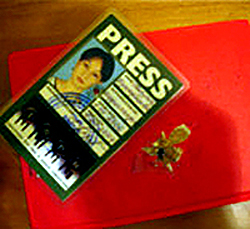Blood Flows in Uzbek Crackdown
IWPR reporter's eyewitness account of scenes of panic as armoured cars spray gunfire randomly into crowds of demonstrators.
Blood Flows in Uzbek Crackdown
IWPR reporter's eyewitness account of scenes of panic as armoured cars spray gunfire randomly into crowds of demonstrators.
 Galima Bukharbaeva's press card and notebook, shoot through during the demonstrations on 13 May 05. |
The assault began at 5.20 pm local time. At least nine people were killed in the first volley of gunfire. Their fellow-demonstrators carried their blood-covered bodies inside the compound of the Andijan regional government building, which was being held by the protesters.
We journalists witnessed these first shootings, but we were unable to make a count of subsequent casualties, because we had to dive for cover ourselves as the shooting continued.
The assault by government security forces was not unexpected. The protesters who had taken control of the local government building were anticipating that the authorities would use force on the first night after the protests began, and had prepared as best they could. Barricades went up, fashioned out of furniture, even safes, dragged out of the government offices. In the compound, men filled bottles to make Molotov cocktails.
In the course of May 13, at least 10,000 people gathered on the square outside – some participants said it was nearer 30,000.
Andijan residents were drawn to the scene, some out of curiosity but others to lend their support. Young people who joined the protest formed an informal militia policing the roads into the city centre within a five-kilometre radius.
The eight-wheeled armoured personnel carriers, APCs, appeared out of nowhere, moving through the streets at speed, past the people on the outer fringes of the rally. The first column of vehicles thundered past without taking any aggressive action.
But a second column arriving five minutes later suddenly opened up on the crowds, firing off round after round without even slowing down to take aim.
This IWPR reporter had a lucky escape when a bullet tore right through the rucksack she was wearing, making a neat hole in her notebook and press card.
People on the square, who were unarmed and included women and children, started screaming and trying to run away.
Inside the regional government, a core of protesters who had got hold Kalashnikov assault rifles moved outside to defend themselves.
"We've nothing to lose - better to die than live the way we do," said one.
It was pretty clear they would lose. "Rifles and petrol bombs aren't worth anything against tanks and APCs," said a bystander.
Overhead, helicopters circled, clearly spying out where the biggest concentrations of people were gathered.
The nucleus of this popular rebellion was formed by friends and relatives of the 23 men on trial this week at Andijan's city court. After hearings on May 10 and 11, judges adjourned the session to consider their verdict.
For the thousands of people waiting outside the courtroom, the sentence was a foregone conclusion. The men were members of a dangerous Islamic group called the "Akramia", prosecutors insisted, and deserved to be locked up.
The defendants and their many supporters said they were successful local businessmen who were innocent of any crime, but were being framed by a regime determined to find ever more "enemies". Akramia was a total fiction dreamed up by the authorities, they argued.
Although the crowds around the court were peaceful and orderly as hearings wound up on May 11, supporters of the accused warned that they would not take a guilty verdict lying down.
When I arrived on the scene, I was able to piece together some of the intervening events that led to such the final explosion of public anger on the night of May 12-13.
Sharif Shakirov, the brother of one of the accused, told me that right after the court hearings, officers of the National Security Service, SNB, started arresting people who'd been outside the court. They even confiscated cars parked nearby that belonged to relatives of the defendants.
The arrests continued through May 12, and that night people went to try to get their friends and family members out of detention. They started at the traffic police offices, and as numbers built up they moved towards a military unit based in the city, where they forced troops onto the defensive and seized Kalashnikovs.
As the night went on, they went to the SNB building for Andijan region, where the newly-arrested people were being held. There was gunfire as SNB officers held off the crowds, and protest leaders said at least 30 people were killed, although in the continuing confusion, there have been no verified casualty figures.
By one in the morning of May 13, the crowds had stormed the Andijan regional government building, and they were to hold onto it and the surrounding area of town until the APCs rolled in the following evening.
There seems little chance now that this confrontation will be resolved without more bloodshed.
Uzbek interior minister Zokir Almatov spoke to one of the protest organisers, Kabuljon Parpiev, by phone before the troops moved in. At first he seemed receptive to their demand that Akram Yuldashev – a jailed Andijan man accused of founding the Akramia group – should be released.
But when Almatov rang back later, his mood had changed and according to Parpiev, "he said there would be an assault even if they had to kill three or four hundred people."
As I left the scene to file this report, shooting was continuing around the regional government building.
Galima Bukharbaeva is IWPR's project director in Uzbekista.
